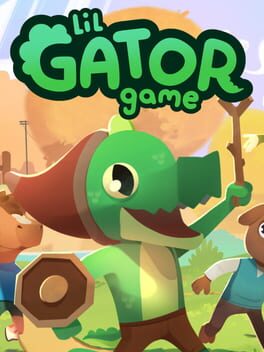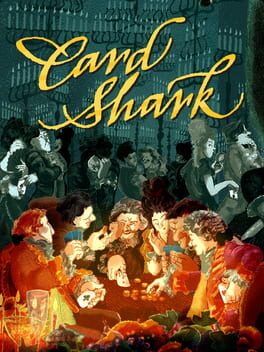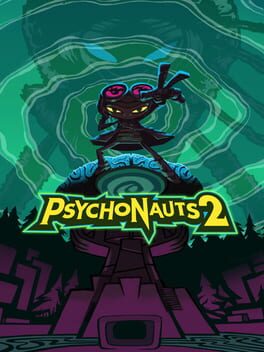lithiumproject
10 reviews liked by lithiumproject
Lies of P
2023
Despite not being particularly arsed about the demo that dropped a few months back, I’ve ended up really enjoying playing Lies Of P, the fairly shameless Bloodborne rip-off from Neowin. It’s good, undeniably so. It manages to capture some of the essential elements of From Software’s masterpiece in regards to how it plays, how the combat and movement feels and wraps it up in an aesthetic that manages to combine some of the best parts of Bloodborne with a pinch of Resident Evil 4 and just a touch of its own vibe and some really, really impressive visuals - it’s a great little package that is well worth your time.
I’ve found it to be a fascinating little thing. I love it. It borrows so much from Bloodborne and, to be fair, mostly the right stuff too and also pulls them off to a high standard. The setting is cool, the performance and visuals are great - the only area I feel you can make a real argument that is superior to Bloodborne, art design aside - and the enemy variety and boss design is cracking too. So, why ISN’T it as good as Bloodborne?
Little things. Tiny details that don’t make a game bad when they aren’t present but are the difference between a game being a damn fine 8/10 and an absolutely essential all-timer 10/10. The kind of touches that get applied to a game by an elite-level game director like Hidetaka Miyazaki instead of some dev studio that previously worked on some forgotten MMORPG.
Now, this may sound like I’m shitting on Lies Of P here so I must stress, I think the game is really good and I do recommend that anyone with a even a passing interest in the Soulslike genre give this a go, but there’s just a few things that add up to make it end up sitting comfortably on the second tier of the genre, rather than rubbing shoulders with the elite. Despite all of the stuff that it does really well, it lacks that special extra sauce.
As great as the visuals are, the level design is a bit simplistic. From Software’s games often allow you much freedom to explore and even tackle areas in any order. They allow you to get lost, get stuck and find secret areas that seem so off the beaten track you’re not entirely unconvinced that you’re the only person to ever have found them. Shortcuts are a key part of the Soulsborne DNA and when you unlock a means of getting from the last checkpoint to a section deeper into an area in second it is a fantastic feeling of relief and satisfaction that you have now made some permanent progression and in Bloodborne they’re expertly weaved into the level design, with some of them not even being clear to you until you’ve actually activated them and suddenly realised where you are. They’re present in Lies Of P and, to be fair, are just as satisfying to unlock but they’re just so obvious - doors locked from one side and faulty elevators that need to be repaired, for instance - that they feel so mechanical. Sure, they’re offering the same end result but they’re just a lot less interesting. Again, small things.
The lack of exploration feeds into a general lack of wonder in Lies Of P. While Bloodborne is intentionally vague with information and details about how to proceed with quests, Lies Of P has a handy indicator on the fast travel screen which tells you if someone has any new dialogue for you or is waiting for a quest item to be handed to them. A brilliant ‘quality of life’ (whatever that means) feature it may be but instantly removes the mystery that creates real life discussion around From Software games, trying to figure out what does what and how to progress quests and find different endings. You’re simply not going to have those brilliant conversations that come from playing From Software games, where you’re asking your mates if they’ve found X or done Y. In Lies Of P, everyone will do everything in order, eventually. It's a linear progression - Level > Boss > Level > Boss > Level… repeat until the end. Very good levels and even better bosses, mind.
There’s also the really old fashioned skill tree full of unlockables that houses some really good and important moves that feel like they should just be part of the starting skill set. With games in this genre I like the idea that you have everything you need to finish the game from the word go and, although I’m sure some maniac will no doubt have completed a no upgrade run in Lies Of P before you’ve finished reading this newsletter, it sometimes feels that you’re missing out on some fairly basic moves.
I’ll admit, I’m being hyper-critical here but when you borrow so egregiously from one of the very best videogames I have ever played, you invite comparisons to that game that are only ever going to come off unfavourably for the most part. As you get further into the game, however, Lies Of P begins to get a bit more comfortable and confident with its own elements and it really starts to shine. The levels get a little more complex. The bosses get more and more challenging with some spectacular designs. You start to really reap the benefits from the unique weapon customisation, which allows you to mix and match head and hilt from any weapon you find, imbuing them with different abilities. You’re forced to experiment with the tools Lies Of P gives you to succeed and you start to see that, as it turns out, ripping off Bloodborne still puts you head and shoulders above a lot of the competition.
There’s three clear areas where I think you can say with confidence that Lies Of P is either superior to Bloodborne or simply brings something to the table that is really smart, unique and undeniably cool. Firstly, it’s the performance. If you think Bloodborne is inferior because it runs at 30fps I think you’re an idiot but let's not beat around the bush, if you’ve got the option of 60fps then take it, man. A special shoutout to the Series S version here, which can run at 1440P/40fps if you have a monitor that can do those weird framerates. Secondly, unlike Bloodborne, there’s a whole load more variety in your build choice thanks to the three starting ‘classes’ and the sheer variety of weapons and customisation possibilities. You can really shape your build around your playstyle in a way that, although present in Bloodborne, is far less nuanced than what you can do in Lies Of P.
Finally, and for my money this is Lies Of P’s one genius idea - the ability to regain one of the Estus Flask equivalents when you have used them all up. Once you’ve healed with your final Estus (or whatever it is called here) you begin charging up a meter by landing hits on enemies. Once filled, you gain your last Estus back. This means that you’re never out of a fight and you’re encouraged to play the game on the front foot. In Bloodborne, when you’re down to the last of your health and you have no means of recovering it against a boss it can feel a little helpless and like you may as well just die and try again. Here, you should never give up. With some skilled play, you can get that bonus Estus and get yourself a health boost when you really need it and then, of course, begin charging another. It’s such a smart mechanic and one that harmonises perfectly with the best elements of this type of game. A near perfect bit of risk/reward.
The thing about Lies Of P is even though you can look at it as a fairly cynical Bloodborne rip that you can play on things other than a PS4 but it turns out a Bloodborne rip is actually still remarkably good. Despite borrowing a whole lot from From Software’s masterpiece it does deliver all of those elements brilliantly and, as you get further and further into Lies Of P, it starts to stamp its own identity onto things. Despite falling short of the truly elite titles it takes influence from, I think Lies Of P sits comfortably above the other ‘best of the rest’ Soulsborne titles like the Nioh games and is easily the finest non-From Software game in the genre. Now, does Neowin fancy having a crack at a Sekiro-a-like next? Whatever they have planned, they’ve certainly gained my attention.
I’ve found it to be a fascinating little thing. I love it. It borrows so much from Bloodborne and, to be fair, mostly the right stuff too and also pulls them off to a high standard. The setting is cool, the performance and visuals are great - the only area I feel you can make a real argument that is superior to Bloodborne, art design aside - and the enemy variety and boss design is cracking too. So, why ISN’T it as good as Bloodborne?
Little things. Tiny details that don’t make a game bad when they aren’t present but are the difference between a game being a damn fine 8/10 and an absolutely essential all-timer 10/10. The kind of touches that get applied to a game by an elite-level game director like Hidetaka Miyazaki instead of some dev studio that previously worked on some forgotten MMORPG.
Now, this may sound like I’m shitting on Lies Of P here so I must stress, I think the game is really good and I do recommend that anyone with a even a passing interest in the Soulslike genre give this a go, but there’s just a few things that add up to make it end up sitting comfortably on the second tier of the genre, rather than rubbing shoulders with the elite. Despite all of the stuff that it does really well, it lacks that special extra sauce.
As great as the visuals are, the level design is a bit simplistic. From Software’s games often allow you much freedom to explore and even tackle areas in any order. They allow you to get lost, get stuck and find secret areas that seem so off the beaten track you’re not entirely unconvinced that you’re the only person to ever have found them. Shortcuts are a key part of the Soulsborne DNA and when you unlock a means of getting from the last checkpoint to a section deeper into an area in second it is a fantastic feeling of relief and satisfaction that you have now made some permanent progression and in Bloodborne they’re expertly weaved into the level design, with some of them not even being clear to you until you’ve actually activated them and suddenly realised where you are. They’re present in Lies Of P and, to be fair, are just as satisfying to unlock but they’re just so obvious - doors locked from one side and faulty elevators that need to be repaired, for instance - that they feel so mechanical. Sure, they’re offering the same end result but they’re just a lot less interesting. Again, small things.
The lack of exploration feeds into a general lack of wonder in Lies Of P. While Bloodborne is intentionally vague with information and details about how to proceed with quests, Lies Of P has a handy indicator on the fast travel screen which tells you if someone has any new dialogue for you or is waiting for a quest item to be handed to them. A brilliant ‘quality of life’ (whatever that means) feature it may be but instantly removes the mystery that creates real life discussion around From Software games, trying to figure out what does what and how to progress quests and find different endings. You’re simply not going to have those brilliant conversations that come from playing From Software games, where you’re asking your mates if they’ve found X or done Y. In Lies Of P, everyone will do everything in order, eventually. It's a linear progression - Level > Boss > Level > Boss > Level… repeat until the end. Very good levels and even better bosses, mind.
There’s also the really old fashioned skill tree full of unlockables that houses some really good and important moves that feel like they should just be part of the starting skill set. With games in this genre I like the idea that you have everything you need to finish the game from the word go and, although I’m sure some maniac will no doubt have completed a no upgrade run in Lies Of P before you’ve finished reading this newsletter, it sometimes feels that you’re missing out on some fairly basic moves.
I’ll admit, I’m being hyper-critical here but when you borrow so egregiously from one of the very best videogames I have ever played, you invite comparisons to that game that are only ever going to come off unfavourably for the most part. As you get further into the game, however, Lies Of P begins to get a bit more comfortable and confident with its own elements and it really starts to shine. The levels get a little more complex. The bosses get more and more challenging with some spectacular designs. You start to really reap the benefits from the unique weapon customisation, which allows you to mix and match head and hilt from any weapon you find, imbuing them with different abilities. You’re forced to experiment with the tools Lies Of P gives you to succeed and you start to see that, as it turns out, ripping off Bloodborne still puts you head and shoulders above a lot of the competition.
There’s three clear areas where I think you can say with confidence that Lies Of P is either superior to Bloodborne or simply brings something to the table that is really smart, unique and undeniably cool. Firstly, it’s the performance. If you think Bloodborne is inferior because it runs at 30fps I think you’re an idiot but let's not beat around the bush, if you’ve got the option of 60fps then take it, man. A special shoutout to the Series S version here, which can run at 1440P/40fps if you have a monitor that can do those weird framerates. Secondly, unlike Bloodborne, there’s a whole load more variety in your build choice thanks to the three starting ‘classes’ and the sheer variety of weapons and customisation possibilities. You can really shape your build around your playstyle in a way that, although present in Bloodborne, is far less nuanced than what you can do in Lies Of P.
Finally, and for my money this is Lies Of P’s one genius idea - the ability to regain one of the Estus Flask equivalents when you have used them all up. Once you’ve healed with your final Estus (or whatever it is called here) you begin charging up a meter by landing hits on enemies. Once filled, you gain your last Estus back. This means that you’re never out of a fight and you’re encouraged to play the game on the front foot. In Bloodborne, when you’re down to the last of your health and you have no means of recovering it against a boss it can feel a little helpless and like you may as well just die and try again. Here, you should never give up. With some skilled play, you can get that bonus Estus and get yourself a health boost when you really need it and then, of course, begin charging another. It’s such a smart mechanic and one that harmonises perfectly with the best elements of this type of game. A near perfect bit of risk/reward.
The thing about Lies Of P is even though you can look at it as a fairly cynical Bloodborne rip that you can play on things other than a PS4 but it turns out a Bloodborne rip is actually still remarkably good. Despite borrowing a whole lot from From Software’s masterpiece it does deliver all of those elements brilliantly and, as you get further and further into Lies Of P, it starts to stamp its own identity onto things. Despite falling short of the truly elite titles it takes influence from, I think Lies Of P sits comfortably above the other ‘best of the rest’ Soulsborne titles like the Nioh games and is easily the finest non-From Software game in the genre. Now, does Neowin fancy having a crack at a Sekiro-a-like next? Whatever they have planned, they’ve certainly gained my attention.
Lil Gator Game
2022
Ghostrunner
2020
Diddy Kong Racing
1997
Card Shark
2022
A borderline masterpiece in using simple controller interactions and mechanics to make you feel like you're performing great things, with a lovely visual style, brilliant soundtrack and a story that ramps up the stakes, as you go from tricking some drunkards out of a few coins to literally putting your life on the line. When you pull off a complicated series of deceptions to win a hand of cards and get yourself out of a particularly sticky situation, its absolutely thrilling. When you're in the middle of shuffling the deck, knowing you're up to no good, you can FEEL the eyes of the other players on you.
This is the kind of thing only videogames can do and it should be rightly celebrated.
This is the kind of thing only videogames can do and it should be rightly celebrated.
Citizen Sleeper
2022
An RPG with a story so finely crafted I'm not even sure I want to replay it to 'see all the other bits' as I normally would. Very content to just enjoy this one run as my story, and that's that.
Citizen Sleeper is arriving at a perfect time because despite its minimalist presentation, it evokes so much emotion. The writing is so excellent, so evocative, that it pulls more feelings out of you than 90% of painstakingly crafted 3D environments and characters in triple A games. Not to say CS's presentation isn't beautiful though; the character portraits and humming score are wonderful partners to the writing. But it's the characters and the script that really sing here. The opening hour makes you feel suitably isolated and desperate. Options are limited and most interactions serve to educate you about how dire your situation is. The people you meet while trying to survive will genuinely change the way you view the setting and make you question what your goal really is beyond just 'survive!' and 'escape!' The forks at the conclusion of some quests will be a struggle not because of what reward you get, or because of some tedious GOOD GUY/BAD GUY meter ticking up - but because you are truly invested in what happens.
Citizen Sleeper is arriving at a perfect time because despite its minimalist presentation, it evokes so much emotion. The writing is so excellent, so evocative, that it pulls more feelings out of you than 90% of painstakingly crafted 3D environments and characters in triple A games. Not to say CS's presentation isn't beautiful though; the character portraits and humming score are wonderful partners to the writing. But it's the characters and the script that really sing here. The opening hour makes you feel suitably isolated and desperate. Options are limited and most interactions serve to educate you about how dire your situation is. The people you meet while trying to survive will genuinely change the way you view the setting and make you question what your goal really is beyond just 'survive!' and 'escape!' The forks at the conclusion of some quests will be a struggle not because of what reward you get, or because of some tedious GOOD GUY/BAD GUY meter ticking up - but because you are truly invested in what happens.
50 Cent: Bulletproof
2005
As a media hub for fans in the pre-Youtube days, Bulletproof is kind of awesome. I was legitimately so excited to be able to play these music videos whenever I wanted -- as alien as that sounds now.
But beyond that, this is a pretty damn horrendous third person shooter and I can't believe I actually enjoyed the video game aspect of this package as a teenager. 50 moves at a glacial pace and you have to turn aim sensitivity all the way up to get a remotely decent aiming experience. There's some cool ideas on paper like taking human shields, interrogating enemies, and slick finishing moves -- but they're all either useless or broken in execution. Likewise there are some level design ideas that sound okay but the mechanics are just not well implemented at all. The cutscenes and story are actually pretty slick all things considered but lack subtitles so even they can't be properly enjoyed.
Oh well, I'll always have the memory of being 14 and watching the Poppin Them Thangs video on a loop.
But beyond that, this is a pretty damn horrendous third person shooter and I can't believe I actually enjoyed the video game aspect of this package as a teenager. 50 moves at a glacial pace and you have to turn aim sensitivity all the way up to get a remotely decent aiming experience. There's some cool ideas on paper like taking human shields, interrogating enemies, and slick finishing moves -- but they're all either useless or broken in execution. Likewise there are some level design ideas that sound okay but the mechanics are just not well implemented at all. The cutscenes and story are actually pretty slick all things considered but lack subtitles so even they can't be properly enjoyed.
Oh well, I'll always have the memory of being 14 and watching the Poppin Them Thangs video on a loop.
Fired this up to distract me from the misery of my beloved football team getting an absolute piping and ended up playing through the entire thing - all objectives and gold medals - in a couple of hours. It's a bit like the original Sonic game in that there's mechanics that get added in later games that are now standards of the series but when stripped back to the basics, there's no surprise that a core of this quality was able to provide the base for countless sequels.
Also: best soundtrack in the whole series, no question. I understand the love for 2 and 3 but there's too much of what was the current popular punk and metal of the time in them and some of that is pretty garbage. When you hear that first delay-drenched chord of Police Truck by The Dead Kennedys you know you're playing a real one.
Also: best soundtrack in the whole series, no question. I understand the love for 2 and 3 but there's too much of what was the current popular punk and metal of the time in them and some of that is pretty garbage. When you hear that first delay-drenched chord of Police Truck by The Dead Kennedys you know you're playing a real one.
Castlevania
1986
[emulated]
It is very funny how enemy movement in 1986 was relatively smooth and dynamic but the player movement was insanely stiff and limited.
By no real standard is this a great platformer with modern eyes; it's just very cheap and frustrating. But you can't deny that music and the general ~vibe~ which is impressive even with technical limitations.
It is very funny how enemy movement in 1986 was relatively smooth and dynamic but the player movement was insanely stiff and limited.
By no real standard is this a great platformer with modern eyes; it's just very cheap and frustrating. But you can't deny that music and the general ~vibe~ which is impressive even with technical limitations.









